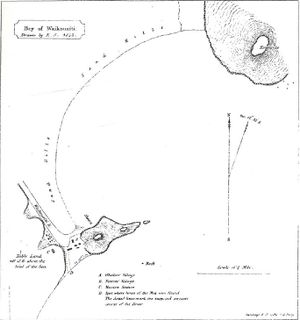Difference between revisions of "Waikouaiti Whaling Station"
(→Location) |
|||
| Line 23: | Line 23: | ||
==Summary of Results== | ==Summary of Results== | ||
While the excavation of the whaling station was informative, Campbell and his crew did not find much beyond supportive evidence that a whaling industrial center had once existed along the coast. | While the excavation of the whaling station was informative, Campbell and his crew did not find much beyond supportive evidence that a whaling industrial center had once existed along the coast. | ||
| + | |||
| + | == References == | ||
| + | {{reflist}} | ||
Revision as of 15:01, 21 February 2010
The Waikouaiti Whaling Station is an early historic site located in New Zealand. It was established in 1837 by Long, Wright, and Richards and sold a year later to Johnny Jones. The whaling station served as a processing center for whale blubber and oil after the whales were captured and killed in the nearby harbor. As an archaeological site, the whaling station provides good evidence for the contact period between Europeans and the Maori, the indigenous Polynesian peoples of the area. Excavation was conducted in November 1992 by Matthew Campbell.
Location
| Waikouaiti whaling station is located in a town called Karitane at the mouth of the Waikouaiti River, 34km North of the city of Dunedin. The city itself is situated within the Otago Region of New Zealand.[1] The river stretches into a salt water lagoon that empties into the sea. This area was deep enough for whales to come into the harbor and made the cliffs along the coast an ideal location for an industrial area focused on whaling. | <googlemap lat="-45.638287" lon="170.654755" zoom="13" height="250" scale="yes" controls="large">
-45.641943, 170.657135, Karitane, Otago, New Zealand </googlemap> |
History
| The Waikouaiti Whaling Station was originally established in 1837 by a group of men named Long, Wright, and Richards. After their company failed the following year, it was sold to Johnny Jones. Jones is accredited for bringing Europeans to the region and establishing the city of the same name that is present today. In 1840, the first settlers arrived aboard the "Magnet." About 100 Europeans were living and farming in the area at the time. Traditional domesticates included chicken and sheep. In addition, 120 Maori lived in a nearby pa, a village or settlement. Archaeology of this area has shown that contact occurred between the groups. Historical accounts of the station describe agricultural fields and cottages along the shore where most of the workers lived. The station continued on through the 1870s during the whaling revival when the Maori built a ship of their own. |
Excavation
Summary of Results
While the excavation of the whaling station was informative, Campbell and his crew did not find much beyond supportive evidence that a whaling industrial center had once existed along the coast.
